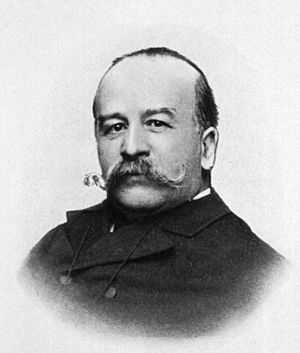Alexandre Lacassagne facts for kids
Alexandre Lacassagne (born August 17, 1843 – died September 24, 1924) was a French doctor and criminologist. A criminologist is someone who studies crime and criminals. Lacassagne was born in Cahors, France. He started a famous way of thinking about crime called the Lacassagne school of criminology. This school was based in Lyon and was very important from 1885 to 1914. It was the main competitor to another famous school of thought, the Lombroso's Italian school.
About His Life
Lacassagne went to military school in Strasbourg. For a while, he worked at the Val-de-Grâce military hospital in Paris. Later, he became a professor of Médecine Légale (which means Forensic Medicine) at the Lyon University. He also started a journal called Archives de l'Anthropologie Criminelle. One of his helpers was a well-known forensics scientist named Edmund Locard.
Lacassagne was a key person in starting the fields of medical law and criminal anthropology. He was an expert in toxicology, which is the study of poisons. He was also a pioneer in studying bloodstain patterns and looking at bullet marks to connect them to specific weapons. Even though he didn't create a system to classify these marks, his work is seen as the beginning of the science of ballistics, which studies how firearms work and how bullets travel.
He was very interested in sociology (the study of how societies work) and psychology (the study of the mind). He looked at how these subjects related to criminal behavior. He believed that a person's natural tendencies and their social surroundings were important reasons for why they might commit crimes.
Lacassagne became well-known for his expert help in several important criminal cases. This included the case of the "malle à Gouffé" in 1889 and the killing of President Sadi Carnot in 1894.
Politically, Lacassagne supported his friend Léon Gambetta. He was in favor of a law from 1885 that set up penal colonies. These were places where people who repeatedly committed crimes were sent. He also did not agree with getting rid of the death penalty (the punishment of putting someone to death). He believed that some criminals could not be changed.
In 1877, he helped start the "Société de Médecine publique et d'Hygiène professionnelle" with Apollinaire Bouchardat and Émile Vallin.
Lacassagne passed away in Lyon.
The Lacassagne School
The Lacassagne School was very important in France from 1885 to 1914. It was the main group that disagreed with Lombroso's Italian School. Its importance was overlooked for a while but has recently been recognized again. In 1913, Lacassagne summarized his main ideas:
- "Society is where crime grows; the criminal is like a seed that doesn't matter until it finds the right conditions to grow."
- "Instead of believing that crime is just a matter of someone's biology, we believe society can take action to prevent it."
- "Justice can fail, prisons can make people worse, and society gets the criminals it deserves."
Lacassagne was first influenced by Lombroso. However, he later disagreed with Lombroso's idea of the "born criminal" or a "criminal type" and Lombroso's strong focus on heredity (traits passed down from parents). Lacassagne, influenced by the sociologist Gabriel Tarde, put more emphasis on how a person's environment affects them. Still, he believed that both environment and inherited traits played a role.
Lacassagne and his colleagues admired Franz Joseph Gall, who started phrenology. Phrenology was an old idea that you could tell a person's character by the bumps on their head. Lacassagne was also influenced by Auguste Comte's positivism, which focused on scientific observation.
The Lyon School saw crime as something that goes against the natural order of society. They thought that the social environment had a physical effect on the brain. This was different from Lombroso, who thought criminal factors were only biological and individual. So, for Lacassagne, the two most important things to study in crime were "biological" and "social" factors. He even divided the brain into three areas, each linked to different types of behavior, and connected these to different types of criminals.
The Lombroso School became more famous than Lacassagne's, probably because Lacassagne kept believing in phrenology, which most scientists at that time no longer trusted. Lacassagne's ideas, which mixed both biological and social factors, were seen as a bit unclear, which might be why they didn't last as long as others.
Quotations
- "Every society gets the kind of criminal it deserves".
See Also
 In Spanish: Alexandre Lacassagne para niños
In Spanish: Alexandre Lacassagne para niños
- Italian school of criminology
- Positivist criminology
- History of psychology
- Alphonse Bertillon
- Marc-André Raffalovich (1864–1934), contributor to the Archives d'anthropology criminelle, writer on homosexuality


